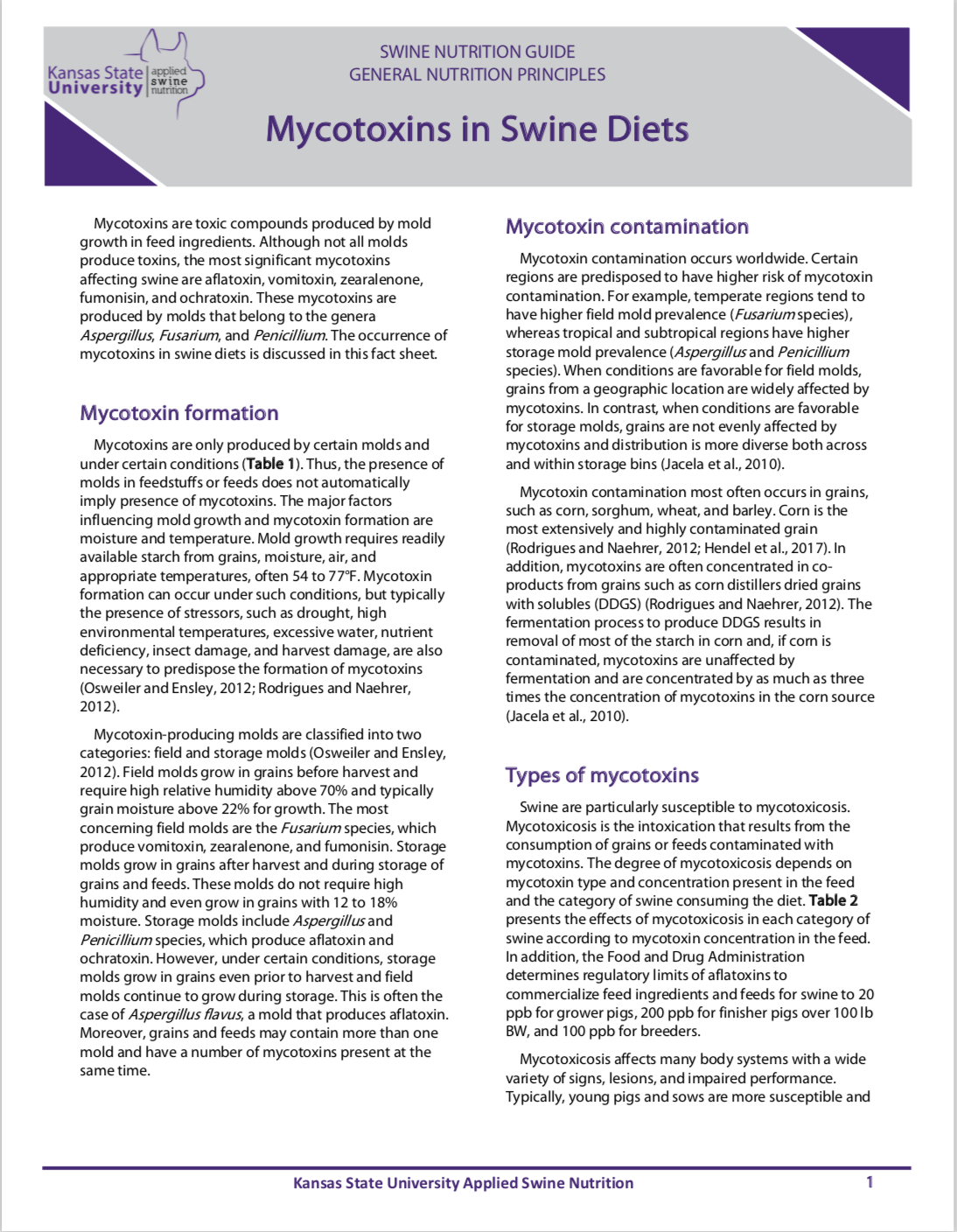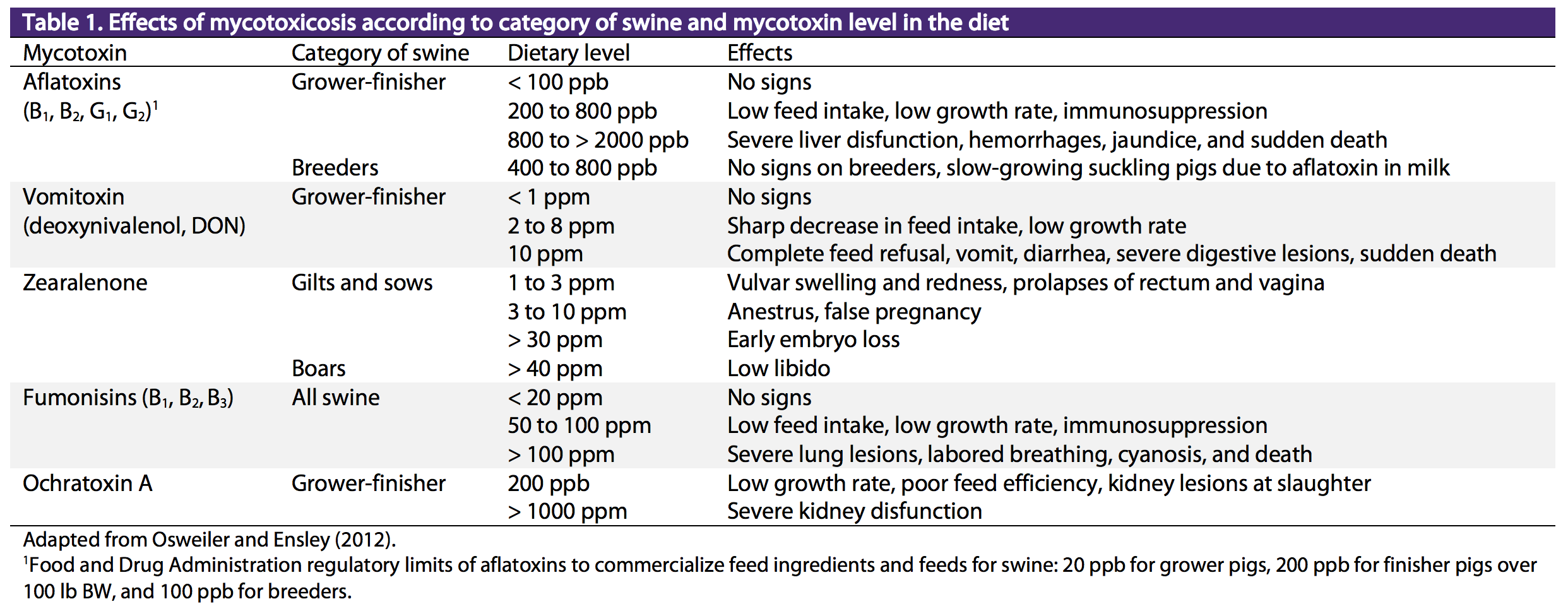What Are Mycotoxins Explain Different Types of Mycotoxins
Examples of mycotoxins causing human and animal illness include aflatoxin citrinin fumonisins ochratoxin A patulin trichothecenes zearalenone and ergot alkaloids such as ergotamine. Mycotoxins are chemical compounds produced by actively growing molds fungi as secondary metabolites that show toxic effects on living beings such as humans animals plants and microorganisms.

The Major Food Borne Mycotoxins Their Main Producing Fungal Species Download Table
These are aflatoxins ochratoxins zearalenone and trichothecenes.

. They are invisible stable and toxic chemical compounds. Mycotoxins are toxic compounds synthetized by fungi either mainly at pre-harvest by Fusarium or mainly at post-harvest by Aspergillum and Penicillium. Types of mycotoxin.
Zearalenone Fusarium roseum Ftricinctum Froseum Culmorum FroseumEquiseti Froseum Gibbosum Froseum Graminearum Foxysporum Fmoniliforme. Mycotoxins are secondary metabolites of low molecular weight and therefore test methods for analysis of mycotoxins face different problems ranging from the need to have a well-equipped laboratory in terms of instrumentation and analytical capacity to personnel with sufficient experience in handling of samples and reference standards. There are between 300 and 400 types of mycotoxins.
Zearalenone ZEN Fumonisin B1 FB1 Trichothecenes vomitoxin or deoxynivalenol DON T-2 toxin and diacetoxyscirpenol DAS. It is located from variety of mold contaminated food like peanuts rice etc. Thus this is the key difference between aflatoxin and.
Types of Mycotoxins The most extensively studied mycotoxins are those produced by the molds Aspergillus Fusarium Penicillium and Claviceps. Secondary metabolites such as mycotoxins are not necessary for normal metabolic function of the fungus. What are mycotoxins explain different types of mycotoxins.
The term mycotoxin is usually reserved for the toxic chemical products produced by fungi that readily colonize crops. Mycotoxins can affect animals in a number of ways. It is believed the effect of mycotoxins as a cause of human mortality is underestimated.
Examples of mycotoxins causing human and animal illness include aflatoxin citrinin. Two major types of toxin include B 1 and G 1 that show blue and green fluorescence when exposed to UV lights. How to remove aflatoxin from peanuts and how to get rid of mycotoxins in your home.
They appear in the food chain because of the contamination of crops by molds these toxins can also contaminate the human being by air. Mycotoxins are natural substances produced by moulds and fungi. Mycotoxins are natural contaminants of different commodities and human exposure to mycotoxins.
Mycotoxins are toxic compounds synthetized by fungi either mainly at pre-harvest by Fusarium or. There are several hundred types of mycotoxins but the most harmful ones with toxic effects on our health are Aflatoxins Ochratoxin A Patulin Fumonisins Zearalenone and Nivalenol. Ad What are the symptoms of aflatoxin poisoning how to get rid of mycotoxins in your body.
The mycotoxins are produced by more than 100 mold species mainly by Aspergillus Penicillium and Fusarium. It is produced by Aspergillus flavus A. Parasiticus and some Penicillium spp.
Feed materials can be contaminated by different mycotoxins depending on the. The term mycotoxin is usually reserved for the toxic chemical products produced by fungi that readily colonize crops. The total number of mycotoxins known to date numbers in the thousands.
Below are some of the mycotoxin symptoms. The extent of adverse effects of mycotoxins on human or animals health mainly depends on the extent of exposure dosage and period type of mycotoxins physiological and nutritional status as well as possible synergistic effects of other chemicals to which the animals or humans are exposed. Mycotoxin Fungal Toxin.
A mycotoxin is a toxic secondary metabolite produced by organisms of kingdom Fungi and is capable of causing disease and death in both humans and other animals. According to World Health Organisation WHO 1969 the mycotoxins associated with human diseases are of four types. ASPERGILLUS MYCOTOXINS AFLATOXINS Essentially produced by Aspergillus.
More than 500 different mycotoxins have been identified to date and most animal feedstuffs are likely to be contaminated with multiple. Mycotoxins are secondary metabolites of certain moulds that are toxic compounds. Mycotoxins are common in the farm environment surviving in many places and on many different types of feed sources.
Mycotoxins are naturally occurring toxins produced as secondary metabolites of diverse fungi with Fusarium spp Aspergillus spp and Penicillium spp as the most common. Below are some of the most common mycotoxin types. Types of Mycotoxin.
A few kinds of cheese such as Gouda cheese are made with yogurt-type cultures like Lactobacillus not fungi Costantini 199899. It is estimated that each fungus on Earth produces up to three different mycotoxins. There are different types of mycotoxins among them aflatoxins are the most poisonous type of mycotoxins produced only by Aspergillus species.
Mycotoxins grow on various foodstuffs under different conditions producing diverse toxic effects against organisms. Some of the key mycotoxins produced by these molds are aflatoxins ochratoxins deoxynivalenol DON vomitoxin T-2HT-2 toxins zearalenone fumonisins mycophenolic acid cyclopiazonic acid and ergot alkaloids. Mycotoxin production is an alternative way of causing diseases by fungi.
Aflatoxins ochratoxin A fumonisins certain trichothecenes and zearalenone. Fusarium Mycotoxins affecting the livestock are. There are so far 18 types of Aflatoxins of which the most toxic.
Moulds that produce mycotoxins are said to be toxigenic or incorrectly toxic moulds. Low immunity against environmental and. Flavus and Aspergillus parasiticus.
According to experts five kinds of mycotoxins are important in human and animal health.

Common Mycotoxins Their Mode Of Action And Consequences In Poultry Download Table

Comments
Post a Comment